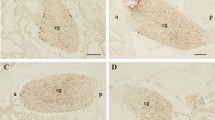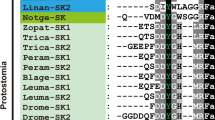Abstract
Immunohistochemical reactivities against short neuropeptide F (sNPF-ir) and crustacean cardioactive peptide (CCAP-ir) were detected in both the brain–subesophageal ganglion (Br-SOG) and midgut epithelial cells of the male American cockroach, Periplaneta americana. Four weeks of starvation increased the number of sNPF-ir cells and decreased the CCAP-ir cells in the Br-SOG, whereas refeeding reversed these effects. The contents of sNPF in the Br-SOG, midgut and hemolymph titer decreased in response to an injection of CCAP into the hemocoel of normally fed male cockroaches, while CCAP titers/contents decreased in response to an injection of sNPF. The results of a double-labeling experiment demonstrated that sNPF-ir co-existed in CCAP-ir cells in the pars intercerebralis (PI), dorsolateral region of protocerebrum (DL), deutocerebrum (De) and SOG. sNPF-ir and CCAP-ir were also colocalized in the midgut. sNPF and CCAP are neuropeptides and midgut factors that interact with each other. Since the two peptides are known to be secreted by identical cells that affect each other, this constitutes autocrine negative feedback regulation for a quick response to food accessibility/inaccessibility. These peptides not only constitute the switch in the digestive mechanism but also couple digestive adaptation with behavior. A CCAP injection suppressed locomotor activity when cockroaches were starved, whereas sNPF activated it when they were fed.














Similar content being viewed by others
References
Audesley N, Weaver RJ (2009) Neuropeptides associated with the regulation of feeding in insects. Gen Comp Endocrinol 162:93–104
Brown MR, Crim JW, Arata RC, Cai HN, Chun C, Shen P (1999) Identification of a Drosophila brain-gut peptide related to the neuropeptide Y family. Peptides 20:1035–1042
Chen ME, Pietrantonio PV (2006) The short neuropeptide F-like receptor from the red imported fire ant, Solenopsis invicta Buren (Hymenoptera: formicidae). Arch Insect Biochem Physiol 61:198–208
Dillen S, Verdonck R, Zels S, Wielendaele PV, Broeck JV (2014) Identification of the short neuropeptide F precursor in the desert locust: evidence for an inhibitory role of sNPF in the control of feeding. Peptides 53:134–139
Fouda MMA, Hiragaki S, Tufail M, Shao Q-M, Takeda M (2010) Precursor structure, distribution and possible functions of pigment-dispersing hormone (PDH) in the terrestrial isopod Armadillidium vulgare (Latreille). J Insect Physiol 56:1728–1737
Fuse M, Zhang JR, Partridge E, Nachman RJ, Orcharda I, Bendena WG, Tobe SS (1999) Effects of an allatostatin and a myosuppressin on midgut carbohydrate enzyme activity in the cockroach Diploptera punctata. Peptides 20:1285–1293
Garczynski SF, Brown MR, Crim JW (2006) Structural studies of Drosophila short neuropeptide F: occurrence and receptor binding activity. Peptides 27:575–582
Hong SH, Lee KS, Kwak SJ, Kim AK, Bai H, Jung MS, Kwon OY, Song WJ, Tatar M, Yu K (2012) Minibrain/Dyrk1a regulates food intake through the Sir2-FOXO-sNPF/NPY pathway in Drosophila and mammals. PLoS Genet 8, e1002857
Hummon AB, Richmond TA, Verleyen P, Baggerman G, Huybrechts J, Ewing MA, Vierstraete E, Rodriguez-Zas SL, Schoofs L, Robinson GE, Sweedler JV (2006) From the genome to the proteome: uncovering peptides in the Apis brain. Science 314:647–649
Ichihara N (2000) Molecular biological study on the neuroendocrine mechanisms of circadian and photoperiodic clocks in insects. PhD dissertation, Kobe University
Jankovic-Hladni M, Ivanovic J, Stanic V, Milanovic M (1978) Possible role of hormone in the control of midgut amyolitic activity during adult development of Tenebrio molitor. J Insect Physiol 24:61–63
Loi PK, Emmal SA, Park Y, Tublitz NJ (2001) Identification, sequence and expression of crustacean cardioactive peptide (CCAP) gene in the moth Manduca sexta. J Exp Biol 204:2803–2816
Matsui T, Matsumoto T, Ichihara N, Sakai T, Satake H, Watari Y, Takeda M (2009) The pars intercerebralis as modular of locomotor rhythms and feeding in the American cockroach, Periplaneta americana. Physiol Behav 96:548–556
Matsui T, Sakai T, Satake H, Takeda M (2013) The pars intercerebralis affects digestive activities of the American cockroach, Periplaneta americana, via crustacean cardioactive peptide and allatostatin-A. J Insect Physiol 59:33–37
Mikani A, Wang Q-S, Takeda M (2012) Brain-midgut short neuropeptide F mechanism that inhibits digestive activity of the American cockroach, Periplaneta americana upon starvation. Peptides 34:135–144
Muraleedharan D, Prabhu VKK (1979) Role of the median neurosecretory cells in secretion of protease and invertase in the red cotton bug, Dysdercus cingulatus. J Insect Physiol 25:237–2340
Nagata S, Matsumoto S, Nakane T, Ohara A, Morooka N, Konuma T, Nagai CH, Nagasawa H (2012) Effects of starvation on brain short neuropeptide F-1, -2, and -3 levels and short neuropeptide F receptor expression levels of the silk worm, Bombyx mori. Front Endocrinol 3:1–8
Nässel DR, Wegener CA (2011) Comparative review of short and long neuropeptide F signaling in invertebrates: any similarities to vertebrate neuropeptide Y signaling. Peptides 32:1335–1355
Park MS, Park P, Takeda M (2009) Starvation induces apoptosis in the midgut nidi of Periplaneta americana: a histochemical and ultrastructural study. Cell Tissue Res 335:631–638
Sakai T, Satake H, Minakata H, Takeda M (2004) Characterization of crustacean cardioactive peptide as a novel insect midgut factor: isolation, localization, and stimulation of α-amylase activity and gutcontraction. Endocrinology 145:5671–5678
Sakai T, Satake H, Takeda M (2006) Nutrient-induced α-amylase and protease activity is regulated by crustacean cardioactive peptide (CCAP) in the cockroach midgut. Peptides 27:2157–2164
Schoofs L, Clyen E, Cerstiaens A, Baggerman G, Wei Z, Vercammen T, Nachman R, De Loof A, Tanaka S (2001) Newly discovered functions for some myotropic neuropeptides in locust. Peptides 22:219–227
Shao QM, Sehadova H, Ichihara N, Sehnal F, Takeda M (2006) Immunoreactivities to three circadian clock proteins in two ground crickets suggest interspecific diversity of the circadiac clock structure. J Biol Rhythms 21:118–131
Shao QM, Fouda MMA, Takeda M (2010) Serotonin- and two putative serotonin receptors-like immunohistochemical reactivities in the ground crickets Dianemobius nigrofasciatus and Allonemobilus allardi. J Insect Physiol 56:1576–1586
Stagier J, Hibich C, Beyreuther K, Keller R (1987) Unusual cardioactive peptide (CCAP) from pericardial organs of the shore crab, Carcinus maenas. PNAS 84:575–579
Strand FL (1999) Gut and brain neuropeptides I. Neuropeptides: regulator of physiological processes. MIT Press, Cambridge, pp 383–431
Thomsen E, Moller L (1963) Influence of neurosecretory cells and corpus allatum on intestinal protease activity in the adult Calliphora erythrocephala Meig. J Exp Biol 40:301–321
Veenstra JA, Lambrou G (1995) Isolation of a novel RFamide peptide from the midgut of the American cockroach, Periplaneta americana. Biochem Biophys Res Commun 213:519–524
Vehovszky A, Agricola HJ, Elliottc C, Ohtanid M, Karpati L, Hernadi L (2005) Crustacean cardioactive peptide (CCAP)-related molluscan peptides (M-CCAPs) are potential extrinsic modulators of the buccal feeding network in the pond snail Lymnaea stagnalis. Neurosci Lett 373:200–205
Wasielewski O, Skonieczna M (2008) Pleiotropic effects of the neuropeptides CCAP and myosuppressin in the beetle, Tenebrio molitor L. J Comp Physiol B 178:877–885
Yamanaka N, Yamamoto S, Zintan D, Watanabe K, Kawada T, Satake H, Kaneko Y, Hiruma K, Tanaka Y, Shinoda T, Kataoka H (2008) Neuropeptide receptor transcriptome reveals unidentified neuroendocrine pathways. PLoS ONE 3:30–48
Acknowledgments
We thank Dr. Hideyuki Inui of the Research Center for Environmental Genomics, Kobe University for facilities and useful discussions and Dr. Susumu Hiragaki for critical reading of the manuscript.
Author information
Authors and Affiliations
Corresponding author
Rights and permissions
About this article
Cite this article
Mikani, A., Watari, Y. & Takeda, M. Brain-midgut cross-talk and autocrine metabolastat via the sNPF/CCAP negative feed-back loop in the American cockroach, Periplaneta americana . Cell Tissue Res 362, 481–496 (2015). https://doi.org/10.1007/s00441-015-2242-4
Received:
Accepted:
Published:
Issue Date:
DOI: https://doi.org/10.1007/s00441-015-2242-4




